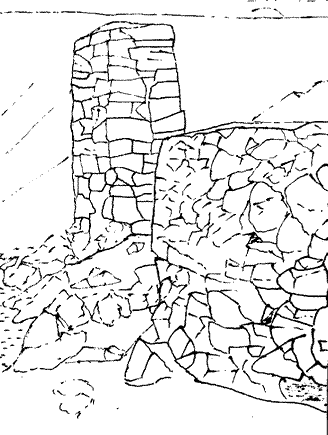RUUD'S TRACK
On the west bank, just north of
the footbridge below Ullern Mill, the path forks with Wilse's original track
leading straight ahead and a new track climbing up to the left.
The new track was cut in the late 1970's by a team from Bærum Municipal
Council led by former ski-jumping champion Birger Ruud.
The track rises to a height of 10-15 metres above river level and passes Ullern Mill which
can be seen on the opposite bank. An extension of Wilse's trail rejoins the
track as it veers left and climbs again to a level some 25-30 metres above the
river. This siting was chosen to overcome the extreme steepness with the
philosophy that there should be as little disturbance as possible. Only
occasional glimpses of the stream are obtained; in places, the path runs along
the back fences belonging to houses in Vollterrasse and Ruglandsveien. The views
are nonetheless among the most spectacular along the valley.
Ruud's Track becomes slippery and almost impassable after rain. A layer of
clay covers most of the area and only rudimentary paving has been attempted. The
steepest slopes have wooden staircases but these too become greasy in damp
weather.
The ruins all lie on the Oslo bank but excellent views of them are available
from Bærum's side. Ullern Mill can be viewed either from water level along
Wilse's Track or from the top of the first rise along Ruud's Track by taking a
couple of steps off the path to the top of the rock outcrop. Five hundred
metres further along, as a marvellous view of Røa Falls opens up, an unmarked
pad leads down to the top of the gorge. This point lies directly across the
river from the site of the Røa Mill which was built
up from river level to the top of the gorge. The lowest stone supports, the end
of the mill race and part of the dam wall are visible today from across the
river.
Fifty metres further along Ruud's Track, around the pond below the Falls,
a second path leads down towards the gorge. From this point directly above
the cascade, the valley widens enough to reveal a view of Holmenkoll Ski Jump
through the tops of the trees.
A further two hundred metres and a long staircase brings us opposite
Holtet Saw Mill. Autumn storms in 1994 brought down trees here and opened up
a glimpse of the ruins.
From here, the path goes down a slope and through a patch of low-lying
ground to the foot bridge at Mehlumøra. At this point a wide track leads up what
was once a slalom slope to Snaret, a residential cul-de-sac leading off
Ruglandsveien. There are several other paths from the local streets to
Ruud'sTrack so Bærum folk have ready access to the river.
The west bank track from here to Grini has existed since long before Ruud's
track was broken in the 1970's. It continues through a stretch of pine and
spruce into the open fields of a tenant farm which belonged to Grini. Grini Mill
comes into view and the track comes down to an asphalt road. Past the Mill
(which houses an architects' office, a furniture maker and an artist's studio
with occasional exhibitions) and beyond the rail bridge lies Verket, the
workers' dwelling for the Brickworks, the site of which is now occupied by a
tennis court. Note the slate roof, the wide eaves, and the long vertical panels
which indicate how high the ceilings are. Much higher than today's Norwegian
residential standard of 2 m 40 (8 feet)! |










